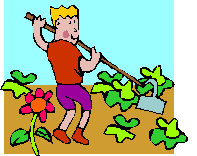 Children
enjoy many of the same pleasures as adults, whether it be baking, woodworking,
or gardening. A main thing to remember, however, is that a child needs to start
with a project that will provide both enjoyment and success to maintain a
continued interest in the project. As such, zinnias make perfect learning tools
-- the seed of zinnias are large, they germinate quickly (with most of the seed
germinating), the plants don't require a lot of care outdoors, and they will
bloom prolifically from mid-summer until the frost kills them in the fall. Seed
can be started indoor four to six weeks before the last expected frost, and
seedlings transplanted into the garden. An easier method is to sow the seed
directly into the garden where they are going to grow.
Children
enjoy many of the same pleasures as adults, whether it be baking, woodworking,
or gardening. A main thing to remember, however, is that a child needs to start
with a project that will provide both enjoyment and success to maintain a
continued interest in the project. As such, zinnias make perfect learning tools
-- the seed of zinnias are large, they germinate quickly (with most of the seed
germinating), the plants don't require a lot of care outdoors, and they will
bloom prolifically from mid-summer until the frost kills them in the fall. Seed
can be started indoor four to six weeks before the last expected frost, and
seedlings transplanted into the garden. An easier method is to sow the seed
directly into the garden where they are going to grow.
Encourage children to take care of their own small garden or
their own portion of a larger garden. For younger children, you may wish to
select a mix of zinnia seed so they can enjoy many bright colors. Your young
gardener can sow a small mass planting, so that when the flowers bloom, the
garden will be a splash of color. Older children may enjoy planning a garden
design with two or more colors of zinnia. If so, explain that simple designs are
more pleasing in small areas than very complex designs.
Help children prepare the soil in the bed. Add organic matter
or slow release fertilizer if needed, then moisten and level the soil. Have the
children draw lines in the soil to mark the planting rows or design. Plant two
or three zinnia seeds 1\4 to 1\2 inch deep in holes spaced 4 to 6 inches apart,
depending on the type of zinnia. If the soil is warm and moist, the seeds will
germinate in three to four days. When the seeds are sown in rows, it is easier
to identify the zinnia seedlings from weed seedlings.
When zinnia seedlings have two pairs of true leaves, they need
to be thinned by pinching off all but the most vigorous seedling at ground
level. Leave about 4 to 6 inches between low growers, 8 to 10 inches between
intermediates, and 10 to 15 inches between large giants.
Zinnia maintenance is very basic, just water, weed, and watch
them bloom. Removing the weeds ensures that the zinnias are getting all the
moisture and nutrients the soil has to offer, and it helps to keep the garden
design attractive. Zinnias do not require a lot of water, but they should be
irrigated during dry weather to keep them blooming at their best. Trickle
irrigation is best as sprinklers tend to increase the chances of disease. Deep,
infrequent watering (soil is wet to a depth of 5 to 6 inches) gets water to the
plant roots where it is most needed better than frequent, shallow waterings.
Zinnias are perfect for picking -- this helps to keep them
blooming and it's great to give Mom or a friend several huge flowers right from
"my own garden" -- so keep scissors or garden shears handy! Growing
plants, such as zinnias, can help children learn how to garden and enjoy
beautifying their outdoor environment. When they have a hand in starting
"life" by germinating seeds and nurturing "life" as they
take care of the plants, children develop skills that they will use all their
lives. The success of a garden of zinnias in full bloom will be a source of
pride and will encourage your young gardeners to tackle more projects in the
future.
![]() Gardeners' Corner
Kids'
Garden
Sustainable Garden
Contact Us
Gardeners' Corner
Kids'
Garden
Sustainable Garden
Contact Us![]()


